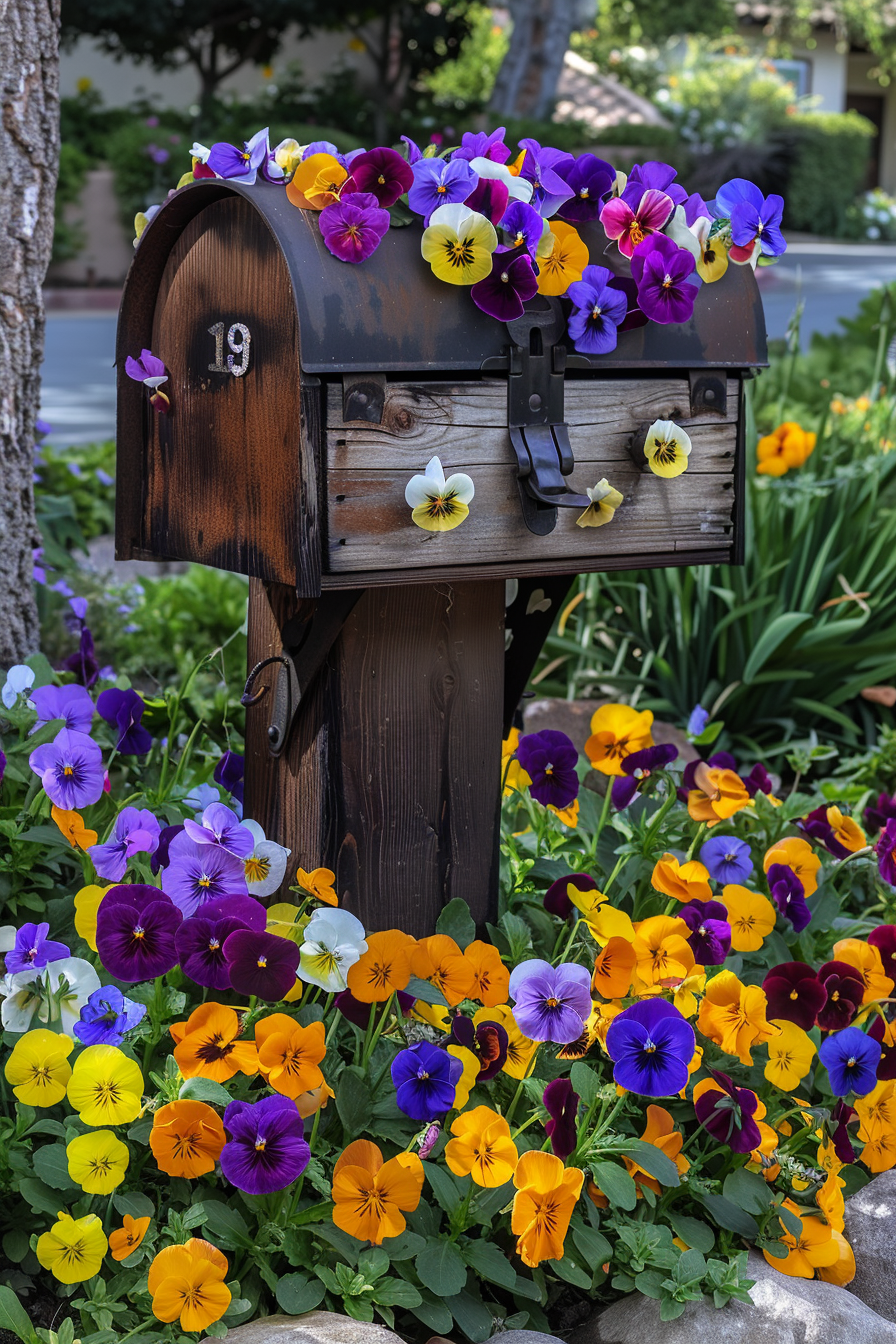Mailbox flower beds are a fun and creative way to add curb appeal and personality to the front of your home.
Placing beautiful flowers and plants around your mailbox is an easy DIY project that can completely transform the look of your yard and entrance.
Vibrant blooms and lush greenery surrounding your mailbox make a great first impression on visitors and passersby.
Beyond aesthetics, a decorated mailbox area also serves as a special greeting for friends, family, and delivery drivers when they come to your home.
There are so many different styles you can do when it comes to mailbox gardens.
You can keep it simple with just a few potted blooms, or go all out with a bed of flowers and vines that extend down the driveway.
The options are endless!
Some popular choices are eye-catching sunflowers, graceful daylilies, cheerful pansies, and fragrant herbs.
You can also incorporate ornamental grasses, evergreen shrubs, and other attractive plants.
Planning your mailbox flower bed is all about what inspires you and what will look best with your home’s architecture and color scheme.
Selecting low-maintenance perennials will also ensure your mailbox garden continues to thrive with minimal effort.
No matter which plants you choose, a flourishing flower bed around your mailbox is a surefire way to make a great first impression.
The blooming beauty will put a smile on visitors’ faces and add welcoming charm to your home’s exterior.
Here are some top mailbox flower bed ideas to inspire your own gorgeous garden greeting!
✨Click to Get My 101 FREE Designer Room Ideas
Sunflower Mailbox Garden
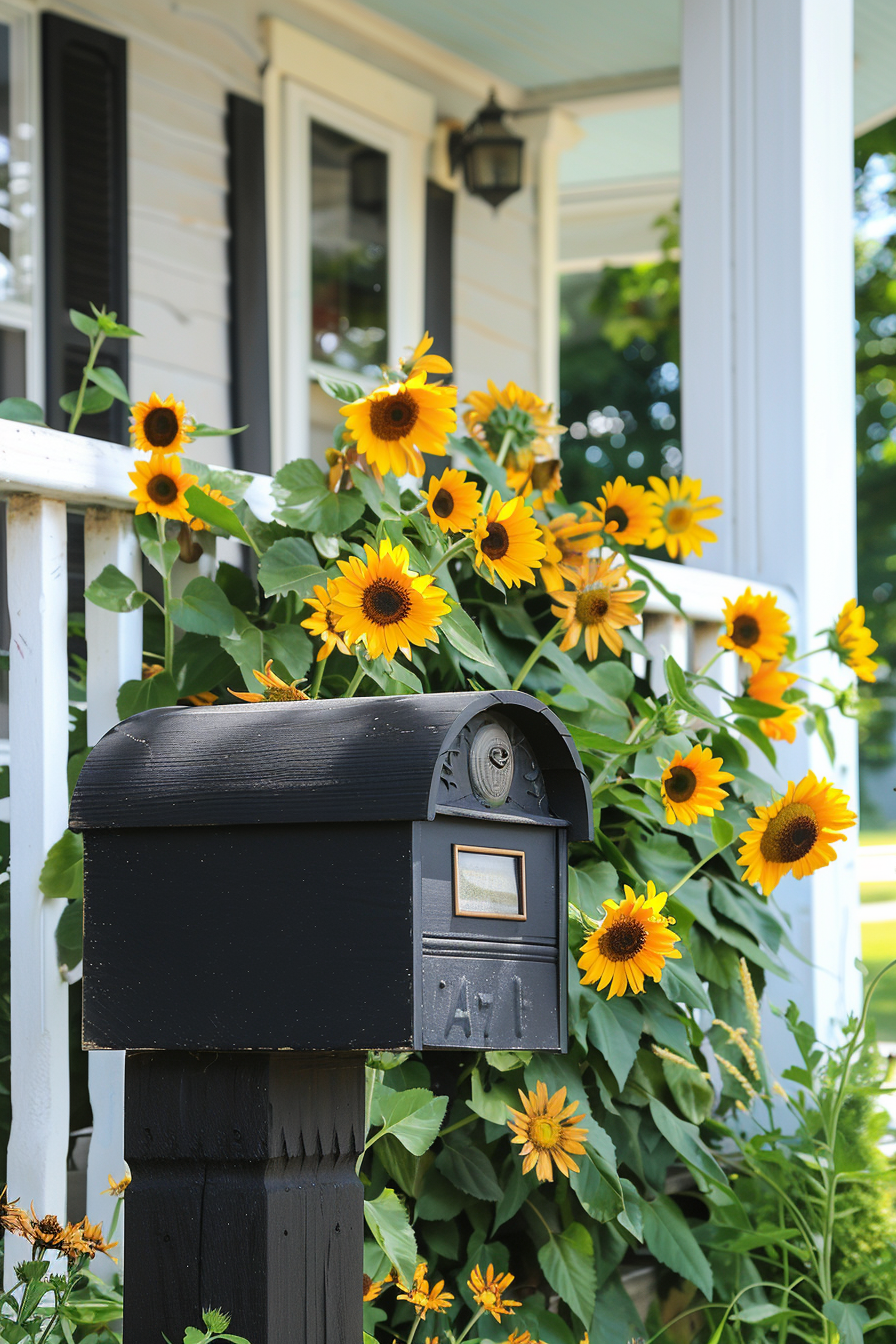
Sunflowers are one of the most popular options for mailbox flower beds, for good reason.
Their tall stalks and vibrant yellow petals are guaranteed to turn heads.
Clustering a mix of dwarf and standard sunflowers around your mailbox creates a joyful burst of color.
This flower choice pairs perfectly with many home styles, adding a cheerful touch to farmhouse, cottage, or traditional exteriors.
The benefits of planting sunflowers in your mailbox garden are plentiful.
Sunflowers are very fast-growing, so you’ll have a beautiful display after just a few weeks.
They bloom profusely through the summer and into early fall.
Sunflowers also attract pollinators like bees and butterflies to your yard.
Their seed heads make a tasty treat for birds as well.
Finally, sunflowers come in a variety of colors like reddish-bronze, pale yellow, and burgundy in addition to the classic bright yellow.
With so much variety, you can find just the right sunflower shades to complement your home.
When designing a sunflower mailbox garden, pair the towering flowers with lower blooms like marigolds, zinnias, or petunias.
Plant the sunflowers in a row radiating out from the mailbox, or cluster several pots of different sunflower varieties around the post.
This allows you to enjoy their gorgeous blooms from all angles.
For optimal growing conditions, make sure the mailbox area gets full sun.
The spot should also have fertile, well-draining soil enriched with compost.
With the right placement and care, your mailbox will be surrounded by stunning sunny flowers from summer into fall.
Pansy Paradise

Pansies are a top choice for mailbox flower beds since they bloom abundantly in spring, fall, and even winter in some climates.
Their colorful, velvety petals add a vibrant pop of color around your home’s entrance.
Pansies come in a diverse array of single and bicolor shades like yellow, purple, blue, white, pink, red, and orange.
You can plant just one pansy variety or mix and match for a rainbow of petals.
The benefit of decorating your mailbox with these cheery flowers is that pansies provide nonstop color.
They tolerate cold better than most blooms, thriving in chilly weather.
In fact, pansies often last through winter with protection from mulch or burlap wrapping.
Their long flowering season means your mailbox flower bed will stay stunning for months on end.
Pansies also spread and reseed easily, filling in your garden bed over time.
Their petite size and short stem length, between 6 to 9 inches tall, make them a perfect low mailbox plant.
When designing a pansy mailbox garden, opt for a well-draining soil mixture amended with compost.
Pansies need at least 6 hours of sun per day.
Plant them in clusters around the mailbox post, allowing their colorful blooms to cascade over the edges.
You can also line them up in neat rows or scatter them informally along the front.
Pansies pair beautifully with ornamental grasses, small shrubs, spring bulbs, and complementary annuals like snapdragons, violas, and ornamental kale.
With minimal care, your lovely pansy-filled mailbox garden will stay vibrant through the changing seasons.
Herb Haven


Herbs make a practical and beautiful addition to mailbox flower beds.
Not only will you have fresh herbs right outside your door, but they also add texture and fragrance to your garden.
Culinary herbs like rosemary, thyme, sage, oregano, lavender, parsley, basil, and mint all make excellent mailbox plants.
You can either plant a full bed of assorted herbs, or add pots of them around your existing flowers.
The advantage of planting herbs in your mailbox garden is you can snip fresh flavors whenever you need them.
Herbs thrive in hot, sunny spots perfect for the front of your home.
They are low-maintenance and do not require much watering once established.
You’ll enjoy their scent and color all season long.
Herbs also help repel mosquitos, flies, and other pests when planted near your front door.
Finally, many culinary herbs feature edible blossoms you can add to recipes too.
When designing a herbaceous mailbox garden, opt for drought-resistant varieties like lavender, rosemary, and sage.
Make sure the area gets at least 6 hours of sunlight and has decent drainage.
Plant tall herbs like fennel and dill towards the back and shorter herbs like thyme up front.
You can also add ornamental touches like painted terra cotta pots or fun garden signs.
Herbs naturally complement perennials like coreopsis, sedum, daisies and grasses for texture.
Your herb mailbox garden will be both beautiful and delicious.
Daisy Delight
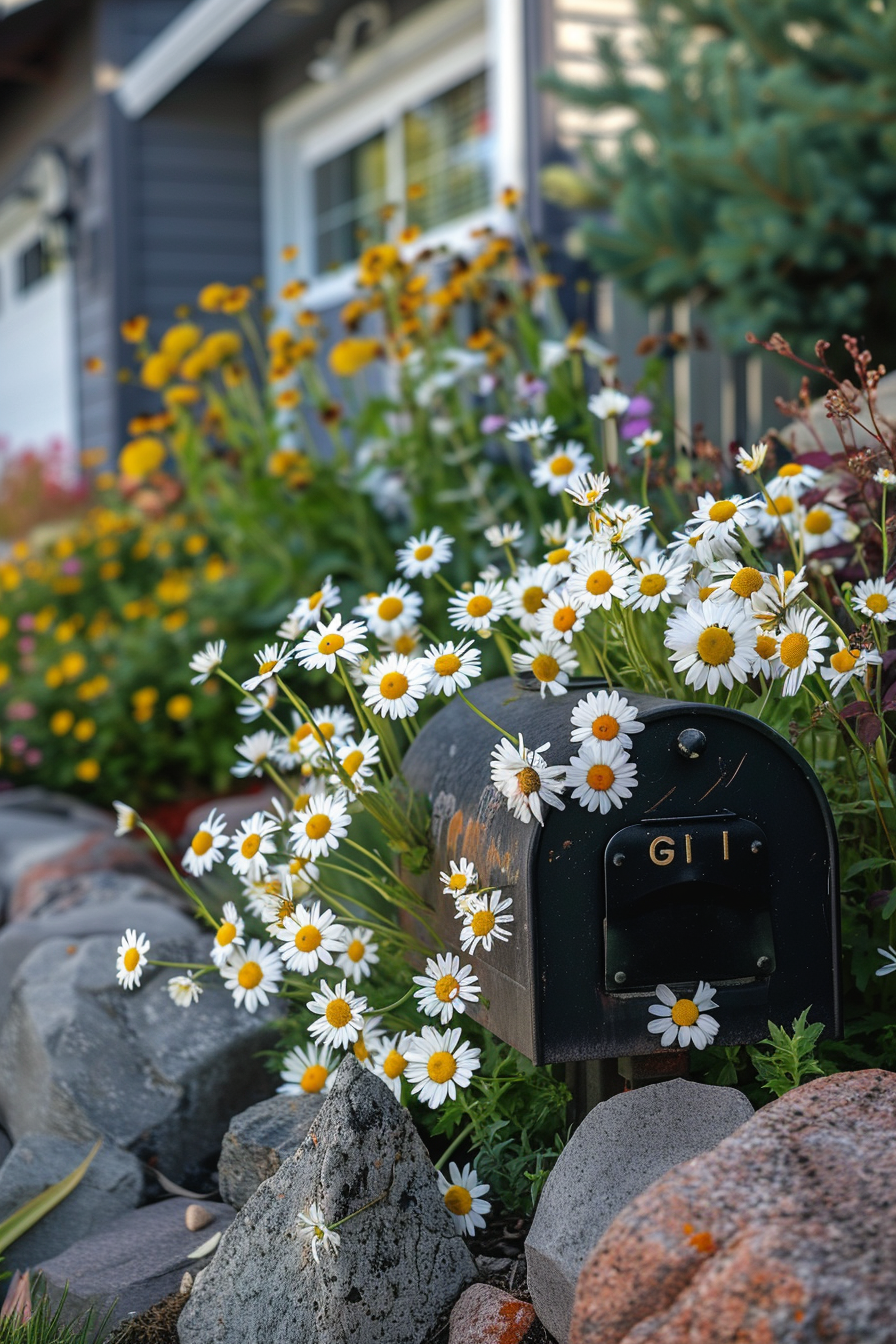
Daisies are synonymous with cheer and sunshine, making them another stellar choice for mailbox flower beds.
Popular picks like black-eyed Susans, Shasta daisies, and gerbera daisies add bold splashes of color around your home’s entrance.
These flowering symbols of happiness thrive in garden beds and containers alike.
You can also find daisies in myriad colors beyond the common white, like pink, yellow, orange, red, and multi-colored varieties.
The benefits of planting daisies around your mailbox are plentiful.
They bloom nonstop from summer through fall with very little care required.
Daisies are perennials that spread prolifically to fill in bare spots and come back each year.
Their bright petals attract butterflies and other pollinators.
Daisies also handle heat and drought much better than many blooms.
For easy care and maximum impact, they are hard to beat.
To design a spectacular daisy mailbox garden, opt for a mix of heights and colors for visual interest.
Plant taller black-eyed Susan vines behind bushy gerbera daisies and creeping perennial Dianthus in front.
For optimal growing conditions, make sure the flower bed gets full sun and has fertile soil amended with compost.
Group the daisies in bunches around your mailbox or scatter them in a naturalistic style.
Accent with ornamental grasses like fountain grass or purple moor grass.
Your daisy mailbox garden will bloom beautifully from the first days of summer through the autumn chill.
✨Click to Get My 101 FREE Designer Room Ideas
Cool Succulents
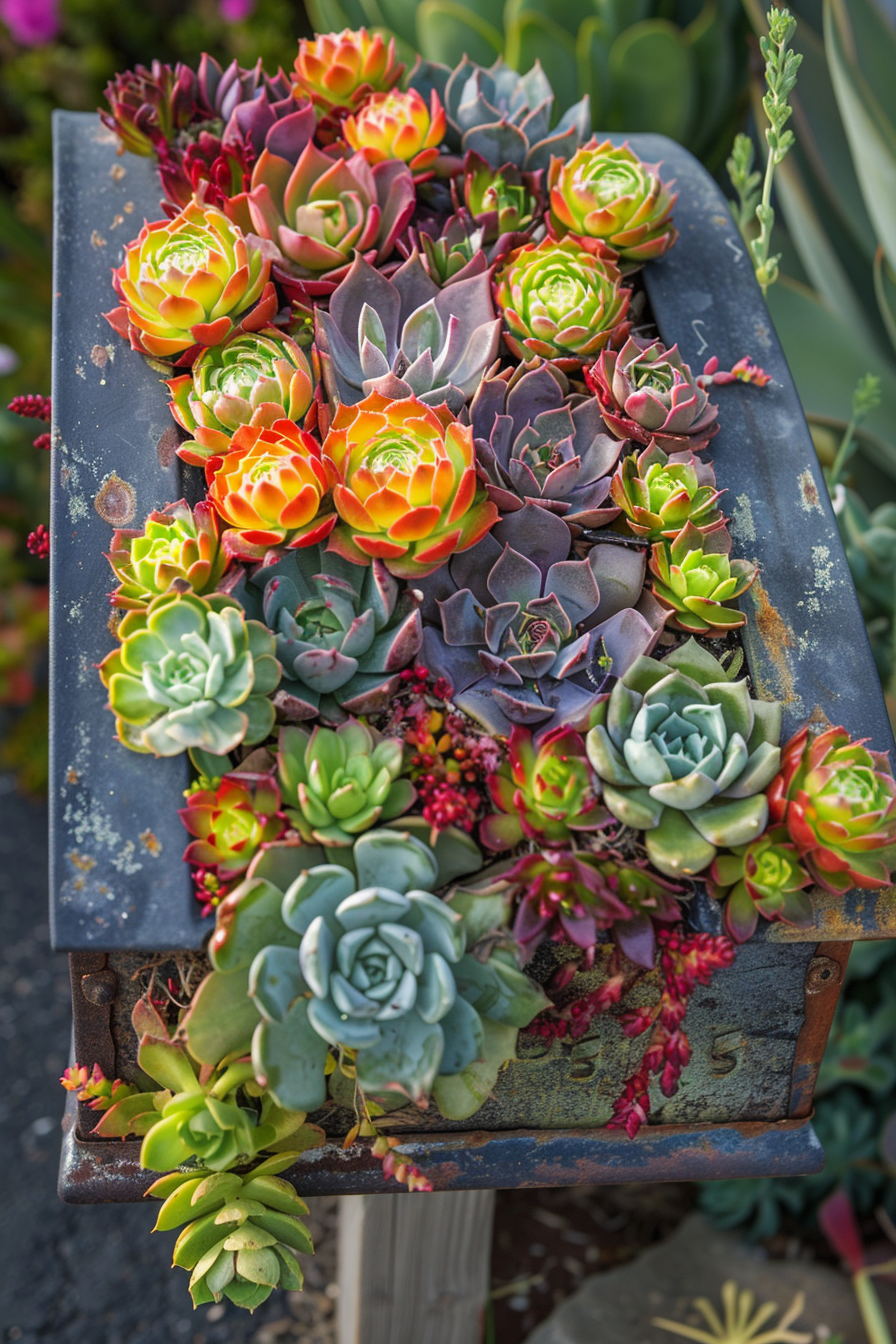
If you want an ultra low-maintenance mailbox garden, succulents are the way to go.
Succulents like aloe, echeveria, jade plant, and sedums are perfect for beginners since they require minimal watering and care once established.
These fleshy plants come in intriguing shapes and textures, from spiky agave to rosette-forming echeveria.
Their colors span the spectrum from bright green to blush pink, deep purple, blue, silver, and beyond.
You can either plant a colorful succulent bed or array pots of them around your mailbox.
The biggest advantage of succulents is their drought tolerance.
Once their root system develops, they only need occasional watering to thrive.
Succulents are also very pest and disease resistant.
Unlike many plants, they do not require fertilizing or nutrient-rich soil either.
Succulents stay compact and tidy, making them ideal small-space plants.
Their unique colors and textures add visual interest around your home’s entrance.
Succulents also work nicely as living decor if you get creative with painted pots or DIY containers.
To design an eye-catching succulent mailbox garden, opt for a range of textures and heights.
Plant rosettes like echeveria near the front and tall, vertical succulents like aloe behind them.
Make sure the bed has very fast drainage, either by amending the soil with grit or planting in raised beds.
Give your succulents full sun for the boldest colors and forms.
Accent them with silver dusty miller, small ornamental grasses, and gravel mulch for a desert garden feel.
Your succulent mailbox garden will provide texture and color with minimal upkeep required.
Daylily Display
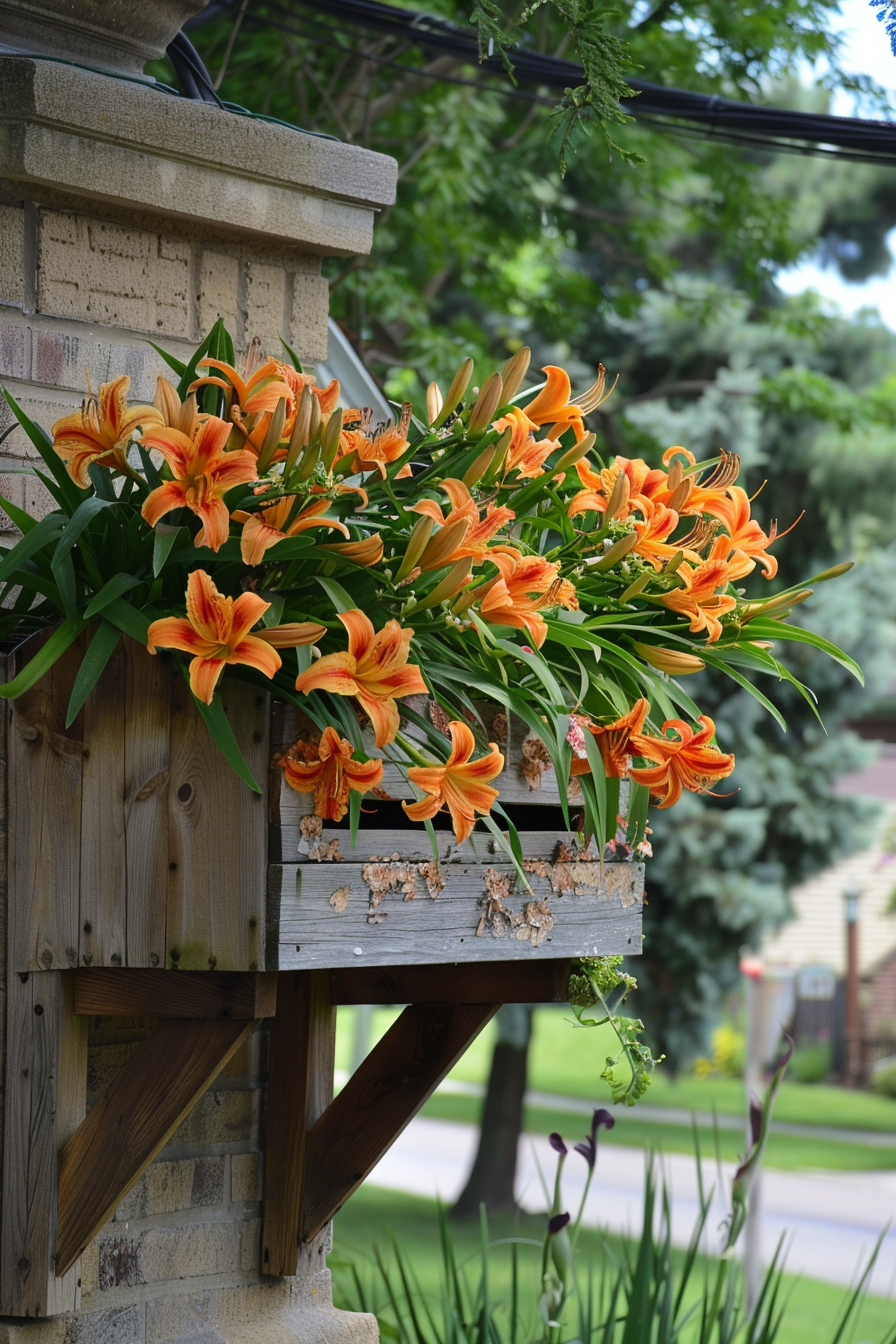
Daylilies are a gardener’s dream with their vivid colors, hardy nature, and nonstop blooms from early summer into fall.
Their big, trumpet-shaped flowers come in every shade imaginable, from bright ruby red to mellow melon orange, sunny yellow, pink, purple, and white.
Daylily flowers only last a day, but each plant produces abundant new blooms on a daily basis.
All this beauty comes with easy care and drought tolerance, making them ideal for mailbox flower beds.
The benefits of daylilies are their flowering power, diversity, and resilience.
Daylilies thrive in full sun or part shade and handle any soil type.
Once established, they require very little maintenance or watering.
The flowers attract hummingbirds and butterflies while repelling deer and other garden pests.
Daylilies spread over time, providing more and more colorful blooms each year.
There are also endless daylily varieties to choose from, allowing you to find just the right colors for your home.
To create a stunning daylily mailbox garden, opt for a mixture of colors and bloom times.
Look for early, mid, and late season daylilies so your garden has nonstop flowers.
Plant the taller, bigger-flowered daylilies toward the back and shorter hybrids up front for the best display.
Give your daylilies room to spread by spacing them 18-24 inches apart.
Mulch well to keep their roots cool and moist.
Accent them with ornamental grasses or evergreen shrubs.
Your daylily-filled mailbox garden will provide joyful, carefree color from spring through fall.
Shimmering Ornamental Grasses

Ornamental grasses add texture, movement, and grace to any flower bed.
Their slender blades come in a rainbow of colors like deep green, sky blue, burgundy, gold, and variegated forms.
Grasses also range widely in height and shape, from fountains of fine foliage to tall, reedy plumes.
They are beautiful on their own but also complement and accent every type of flower.
The benefits of ornamental grasses are many.
Once established, most types thrive with minimal water or fertilizer.
They are very low maintenance, only requiring cutting back once a year.
Grasses grow well in challenging conditions like drought, heat, and poor soil.
Their slender leaves add intriguing color and form without overwhelming small spaces.
Grasses also provide needed winter interest when flowers fade.
enfin, grasses attract less disease and pests than many flowering plants.
There are so many stunning ways to incorporate ornamental grasses into your mailbox garden.
For a tropical look, use clumps of bushy foliage like maiden grass.
Go contemporary with tall, architectural grasses like moor grass or fountain grass.
Sedges like Carex provide popping color and texture in rainbow hues.
Pair complementary grasses with your favorite flowers, like airy purple plum grass with daisies or vivid red Japanese blood grass with daylilies.
Your ornamental grass mailbox garden will provide beautiful texture and graceful movement all year long.
Evergreen Shrubs for Year-Round Interest

Flowers make a big impact, but they fade as cooler weather arrives.
For a mailbox garden with year-round appeal, incorporate evergreen shrubs into your design.
Compact evergreen bushes like boxwood, euonymus, yew, juniper, camellia, and holly keep your mailbox area looking tidy and vibrant even during the winter months.
The advantage of evergreen shrubs is they maintain their foliage color all year, providing structure and interest when flower beds go dormant.
They are also very low maintenance, only needing occasional pruning and shaping.
Many evergreen shrubs feature ornamental elements like colorful berries or contorted stems.
They provide food and shelter for birds when wintry winds blow.
Compact evergreen bushes also give your mailbox flowers and plants a nice backdrop and base layer.
To design a four-season mailbox garden, opt for hardy evergreen shrubs that fit your climate zone.
Use them to anchor the corners of your flower bed or as edging.
Be sure to leave enough space between the shrubs and your mailbox.
Low-growing evergreens like heath, heather, and boxwood make excellent mailbox garden plants.
Accent them with vivid winter plants like coral bark maple, cyclamen, and decorative kale for nonstop curb appeal.
With the addition of evergreen shrubs, your mailbox flower bed will maintain its beauty and definition even during the dormant winter months.
✨Click to Get My 101 FREE Designer Room Ideas
Vibrant Flower Tower
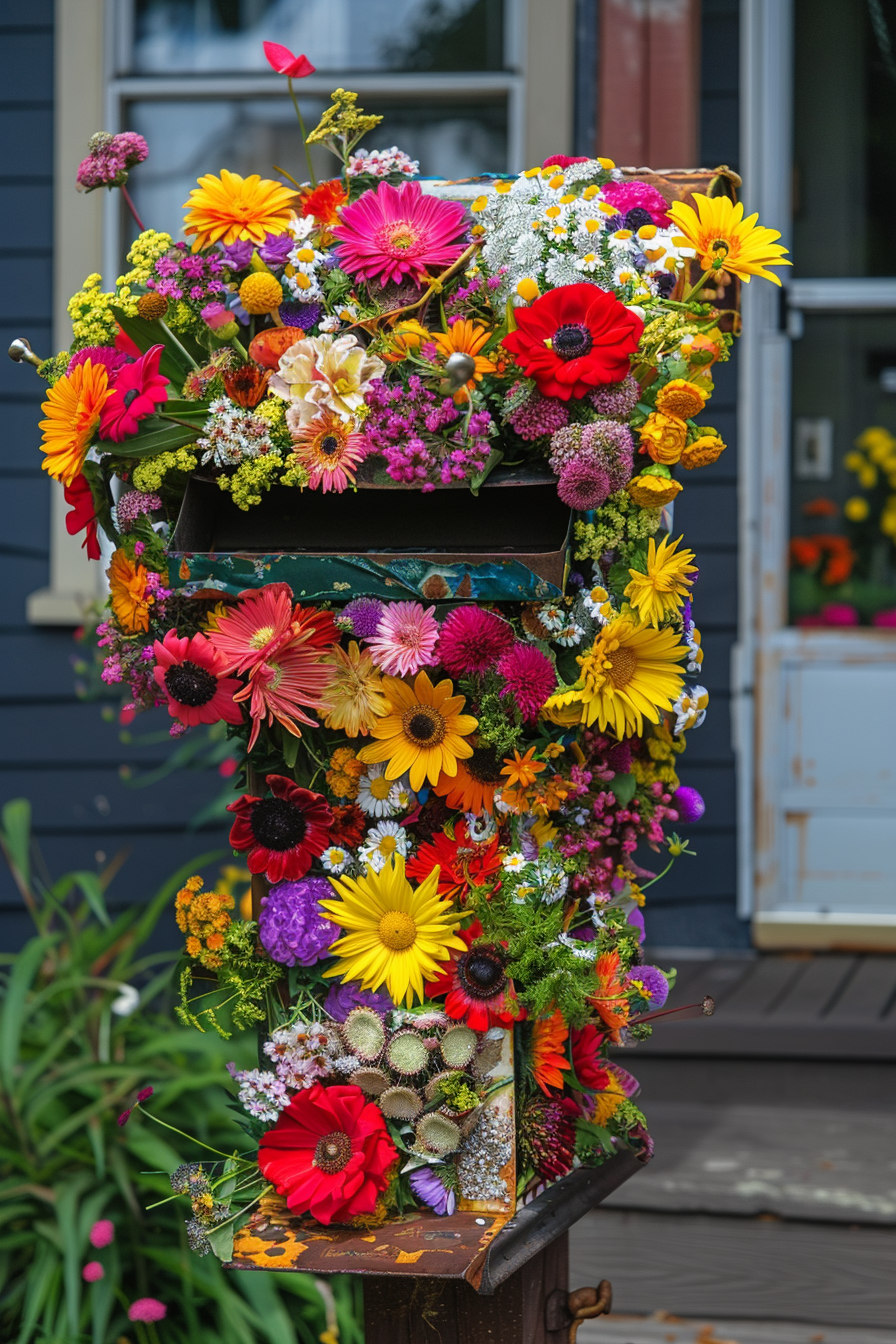
If you have limited yard space, creating a vertical flower tower around your mailbox is a beautiful option.
You can either install commercial metal tiers designed for this purpose or make your own DIY version using planks or PVC pipe.
Fill the towering tiers with pots of bright blooms like petunias, impatiens, marigolds, begonias, geraniums, lobelia, and fuchsia.
This vertical garden adds gorgeous color while using minimal ground area.
The main advantage of a flower tower mailbox garden is maximizing your planting space.
Going vertical allows you to tuck many more plants, color, and texture into a compact area.
Towers also bring the eye upward, creating a focal point.
You can customize a tower’s height to suit your mailbox’s scale and your yard’s proportions.
Flower towers work especially well for small, urban lots or condo landscapes.
Finally, displaying flowers at varying heights creates more visual interest.
When designing your own mailbox flower tower, first assess your mailbox’s size and garden space.
Create or buy a tower that fits the spot without crowding.
Be sure to use weather-resistant materials that can support plenty of weight.
Opt for lightweight potting soil, dense blooms, and generous drainage holes to prevent sogginess.
Include trailing flowers like ivy or lobelia that will cascade over the edges of each tier.
Pair your flower tower with decorative touches like colorful pots, whimsical signs, and solar lighting.
Your vibrant mailbox garden will maximize vertical space to create a stunning floral focal point in your landscape.
Water Wise Mailbox Garden

If drought-prone conditions are a concern in your climate, select drought-tolerant plants for your mailbox flower bed.
Succulents, ornamental grasses, herbs, sedums, yarrow, lavender, coreopsis, gaillardia, verbena, agave, and salvias are all excellent water wise choices.
Beyond plant selection, design your garden with conservation in mind.
The benefits of a water wise mailbox flower bed are saving resources and money.
Once established, drought-tolerant plants can thrive solely on rainwater in many cases.
Their deep root systems make them very efficient at accessing soil moisture.
You’ll spend less time and money watering when you landscape with resilient, low-water blooms and foliage.
A water wise garden also promotes biodiversity by providing habitat for birds, pollinators, and other wildlife.
Finally, properly mulching your mailbox garden will further lock in moisture and reduce water needs.
To design an effective water wise mailbox garden, select a mix of plants that enjoy dry conditions.
Space the plants further apart to minimize competition for water.
Amend the soil with gravel or sand to improve drainage.
Mulch well to prevent evaporation.
Harvest rainwater by directing a downspout into a rain barrel.
Look for native plants most adapted to your climate.
Let your garden go dormant and brown during drought instead of irrigating.
With smart plant choices and design, your mailbox garden can withstand dry weather beautifully while conserving precious resources.
Alluring Fragrance Garden

Surround your mailbox with sweetly scented blooms and herbs to create an intoxicating fragrance garden.
Some wonderfully aromatic plants for this purpose include gardenias, lilacs, jasmine, nicotiana, dianthus, roses, lavender, mint, thyme, lemon verbena, and fragrant tea olive shrubs.
You’ll enjoy a delectable perfume each time you fetch your mail.
The benefit of planting fragrant flowers and foliage around your mailbox is you can indulge in their scent frequently.
Catching a drift of sweet aroma when you’re coming or going adds joy to your day.
Fragrant plants also attract pollinators while repelling pests.
Enhancing your mailbox area with scent improves your yard’s ambience.
It’s a simple way to delight your senses and add welcoming curb appeal.
To design an enticing fragrance garden, opt for a mix of floral and herbaceous scents.
Include both immediate sources like roses and nicotiana along with background fragrances like tea olive or jasmine.
Site your fragrance garden where the breeze can waft scents to your front door.
Give your fragrant plants ample sun and rich soil to encourage the best aroma production.
Time their bloom periods so you have nonstop scented flowers from season to season.
Your mailbox will emanate warm, sweet perfume whenever you go to gather your daily mail.
Pollinator Paradise

Turn your mailbox area into an oasis for bees, butterflies, hummingbirds, and other essential pollinators.
Plant a diverse selection of pollinator-friendly blooms like coneflowers, lantana, cosmos, bee balm, penstemon, salvia, pulmonaria, catmint, and wildflowers like milkweed and blazing star.
You’ll give back to nature while enjoying the sight of happy pollinators flitting through your garden.
A pollinator-friendly mailbox garden benefits your local ecosystem as well as the global one.
More than 75% of flowering plants rely at least somewhat on animal pollinators.
Providing habitat for pollinators helps maintain healthy plant communities that support all life, including humans.
Specific plants also attract and nourish particular pollinator species, like milkweed for monarch butterflies.
Beyond supporting nature, a diverse pollinator garden blooms from spring through fall and draws in charming wildlife.
When designing your mailbox pollinator garden, opt for mostly native plants suited to your region and avoid modern hybrids.
Include single daisy-type blooms, tubular flowers, clustered blossoms, and different colors to attract diverse pollinators.
Avoid pesticides and fertilizers which can harm pollinators.
Include water sources like a small birdbath or fountain.
Your yard will come alive with bees, butterflies, hummingbirds, and other amazing creatures sustaining our planet one flower at a time.
✨Click to Get My 101 FREE Designer Room Ideas
Edible Gardens

An edible mailbox garden lets you grow tasty fruits, vegetables, and herbs right in your front yard.
Opt for compact varieties of crops like lettuce, kale, spinach, radishes, carrots, beets, green onions, beans, peppers, strawberries, and culinary herbs.
You can either plant a full edible garden bed or mix ornamentals and edibles.
The benefits of growing food around your mailbox are convenience, beauty, and savings.
Having fresh ingredients right outside your door makes cooking and snacking more fun.
Many vegetables and herbs feature ornamental leaves and flowers as well.
Planting and tending crops keeps you engaged with your yard and nature’s cycles.
And harvesting free homegrown produce cuts down on grocery costs.
Some edible plants like kale or Swiss chard also provide cool-weather interest when flowers fade.
When designing your mailbox food garden, make sure the area gets full sun.
Amend the soil with lots of compost for fertility.
Use compact varieties suited to containers if your space is very limited.
Plant low-growing crops near the front and taller ones behind.
Include edible flowers like nasturtiums and calendula.
Your mailbox veg garden may inspire passersby to grow their own tasty crops!
Designing a custom mailbox flower garden is a fun, rewarding way to enhance your home’s curb appeal.
With so many gorgeous options for floral styles, colors, textures, and themes, you can create a mailbox garden that perfectly expresses your personal taste.
Beyond beautifying your yard, decorating your mailbox with lovely plants and flowers also creates a welcoming first impression on all who visit your home.
They’ll know they’ve arrived somewhere special when they’re greeted by your vibrant garden paradise.

